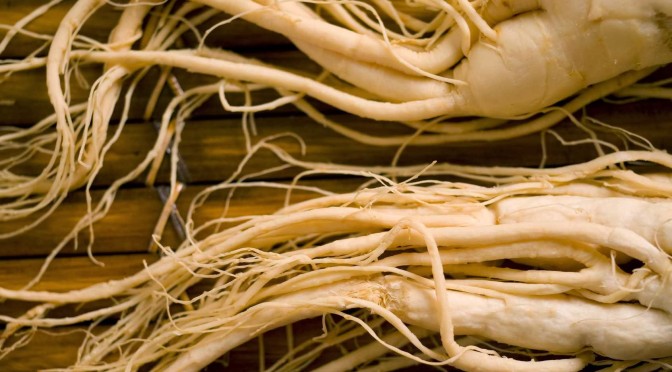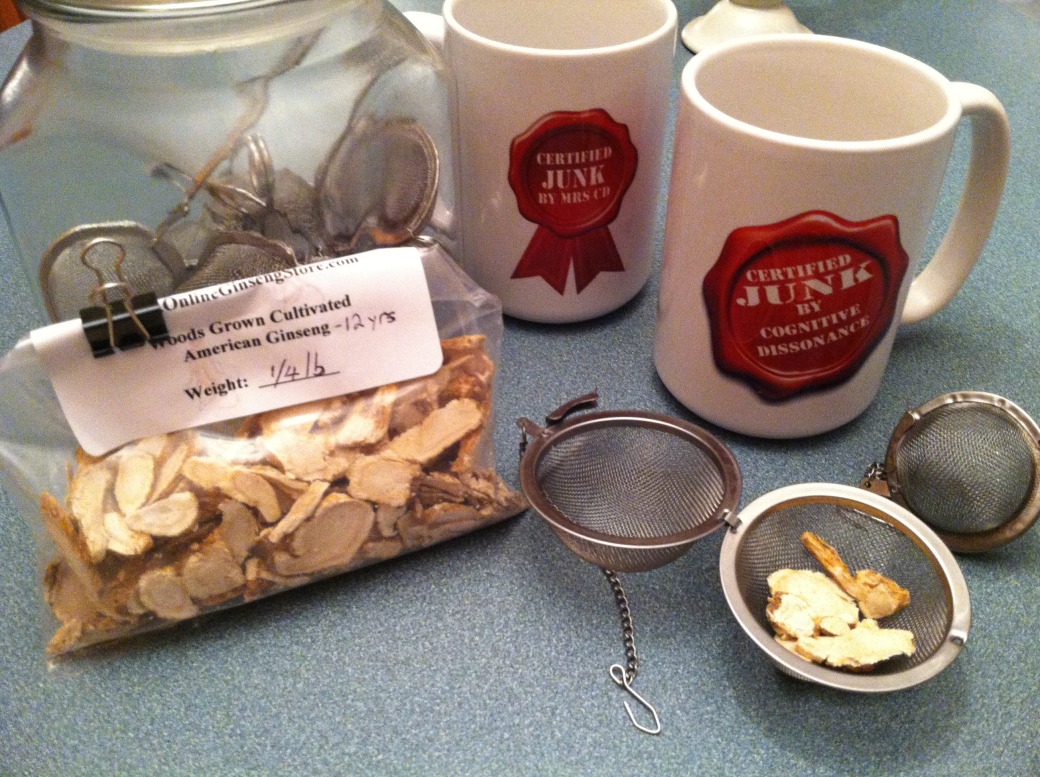From Mrs. Cog's Corner
The content on this page is for discussion purposes relating to health and well being only and is not intended to be medical advice. Links and sources provided are for informational purposes and do not represent an endorsement of a person, product or treatment.
Referred to as the world's most valuable healing plant and purportedly having magical properties, records of ginseng go back as far as recorded human history. India's Vedas written more than 5,000 years ago reference ginseng. It's uses have been traced to food sources and medicine as long ago in Manchuria. Not only is there a record of the royal families of the ancient Chinese dynasties using ginseng as a miracle drug, but the native American Indians used it as well in many herbal remedies and to ward off evil. The history of ginseng is a fascinating study.
Although there are eleven species of ginseng, there are two that are most commonly used in modern times. Panax Ginseng, also known as Asian ginseng or Chinese or Korean ginseng, is popular worldwide and it's benefits are widely accepted. The other is Panax Quinquefolius or American ginseng.
Traditional Chinese medicine teaches that Panax or Asian ginseng is used to promote higher cognitive abilities and a healthier immune system. It is described as having "warming" effects, considered to be yang, and thereby improving circulation. More information on the properties of Panax can be found here.
American ginseng differs somewhat from its Asian cousin and has it own set of benefits and effects. Its properties are more "cooling" bringing effects of moisturizing, revitalizing thus the yin.
In recent centuries, wild grown American ginseng's popularity as an export to Asia has caused it to be reduced to an endangered species. To supplement the lack of wild American ginseng, a method for cultivating it has been developed referred to as "woods grown" ginseng. Like the wild grown, woods grown ginseng roots develop in the mountainous cool forest beds and take six to eight years to mature. More potent roots are not harvested until ten to twenty years of growth.
When I began to research the medicinal properties of (North) American ginseng, I frequently read mainstream accounts which claimed the positive effects of it were greatly exaggerated and even a myth. Usually if there are widespread reports of a natural substance not working as well as it is purported to, there are only limited clinical studies and academic sources to refute the claim. This is not the case with American ginseng.
According to recent studies American ginseng is a source of antioxidants and it boosts the immune system. It has been shown to cause cell death in gastric cancer, has been effective in stopping the spread of colon cancer and leukemia. In fact, more than 350 studies reveal that American ginseng is a wonderful resource for treatment of diabetes, metabolic conditions, immune disorders and more.
As with food or other herbs or bee products, I want to know the source and purity of what I am consuming. I buy my "woods grown" ginseng directly from ginseng farmers who have been in business for many years and are reputable in the business.
Below you can see what approximately 3 ounces of sliced ginseng looks like and how simple it is to prepare for tea in a mesh ball. I usually extract two cups of tea from a mesh ball of ginseng, then oftentimes I will open it up and dip the warmed ginseng in honey in order to eat it. The sweetness of the honey is more than adequate to mask the bitter taste of the ginseng.
Ginseng is one of the best known and most frequently studied medicinal plants worldwide. This is for good reason—ginseng benefits just about every system in the body in one way or another. There are a number of different types of ginseng. The species of ginseng that is most commonly used around the world is Panax ginseng, also known as Korean or Asian ginseng. Its official botanical name is Panax ginseng C.A. Meyer. American ginseng (Panax quinquefolius) is another commonly used and well-studied species. The word “Panax” is derived from the Latin "Pan," meaning “all,” and "Akos," meaning “cure.” If any herbal medicine is truly a cure-all, ginseng is it. Its broad range of therapeutic effects includes everything from fighting fatigue to preventing cancer. http://www.motherearthnews.com/natural-health/rginseng-benefits-research-zbcz1402.aspx
Ginseng news, articles and information: http://www.naturalnews.com/ginseng.html
Ginseng has been a prized medicinal root for thousands of years. Due to the numerous ginseng benefits, the herb is often considered a ‘cure-all’. From increasing energy levels and improving memory, to boosting sex drive and encouraging vascular health—this is truly a healing plant worth talking about. http://naturalsociety.com/ginseng-benefits-exploring-energizing-medicine-plant/
More about American Ginseng: http://www.youtube.com/watch?v=ThuMMAlfmcc#t=29


I started drinking ginseng tea 40 years ago and have kept a cup steeping for sipping on the wood stove most every day since. I dunno if it’s contributed to my lack of prostrate problems or my non-stop virility or my downright pleasure in walking so much last summer culminating in a 22 mile, 7,000′ elevation gain (and loss) day, or if it helped me cure a knock down drag out 6 year bout with chronic fatigue, but hey, I keep drinking it. Just last week I started looking into growing it here, so fancy that, seeing Mrs Cog post this! And, my 2 cent on the making of tea out of this delectable root- chop it finer, and steep it not boiling, but warm, for a long period, it keeps producing.